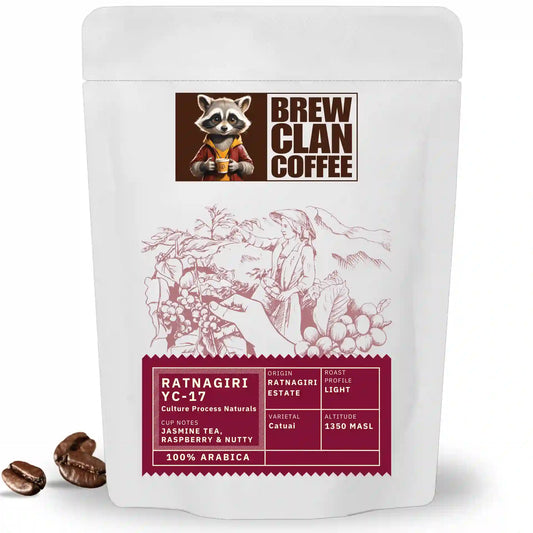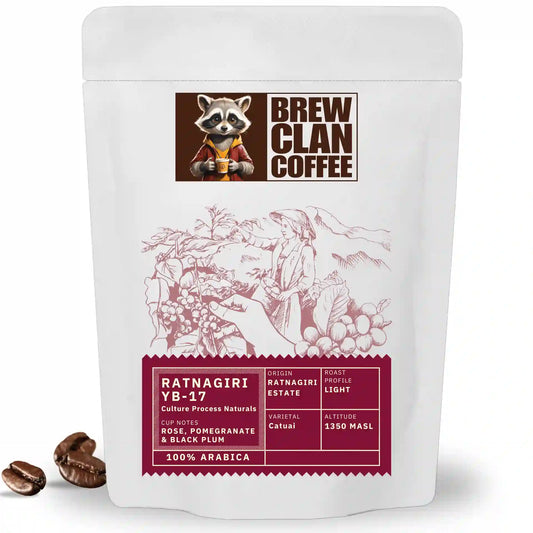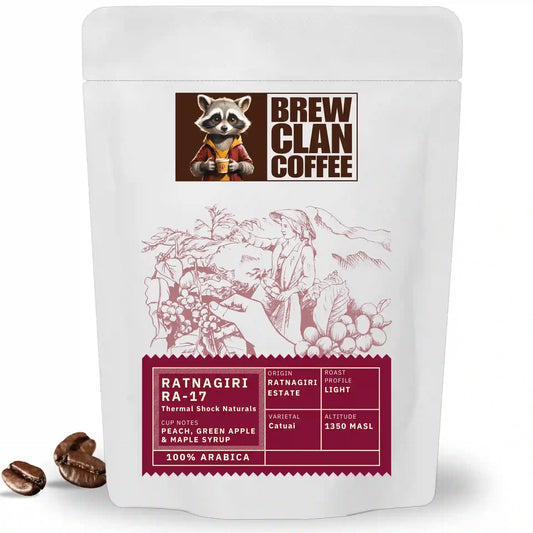
Espresso at Home: Tips for Consistent Shots
Share
Let’s be real for a moment: pulling consistent espresso shots at home can feel like a mad science experiment, a pinch of this, a second less of that, and suddenly your cup tastes like victory… or vinegar.
But once you understand the building blocks, you’ll realize it’s less magic, more muscle memory.
This guide is here to walk you through dialing in espresso, step by step. So grab your tamper and let’s break it down.
Step 1: What all you need to extract the perfect Espresso shot
At a minimum:
- Espresso machine (semi-automatic or manual preferred)
- Burr grinder (stepless if possible, for micro-adjustments)
- Tamper
- Digital scale
- Timer
- Fresh, specialty-grade espresso beans (like BrewClan’s curated offerings – roasted to order)

Optional yet recommended: bottomless portafilter (great for troubleshooting), distribution tool, shot mirror (for your inner espresso nerd).
Step 2: Understand the Holy Trinity — Dose, Yield & Time
This is espresso’s golden triangle, and getting these three right is what people mean by “dialing in” your espresso.
1. Dose
This is how much ground coffee goes into the portafilter.
Standard: 18g for a double shot (though can range between 16–20g depending on your basket and preference)
Tip: Use a digital scale and be exact — even a 0.2g change can affect taste.
2. Yield
This is how much espresso you get in the cup.
Target: 36g for a 1:2 ratio (common starting point)
Want it stronger? Go for 1:1.5 (aka “ristretto”). Lighter? Try 1:2.5 (aka “lungo”).
3. Time
This is how long the shot takes to pull.
Aim for 25–30 seconds for a double shot
Start the timer from the first drop of espresso, not when you press the button

Step 3: Dialing In – How to Make Good Espresso at Home
Here’s how a live barista would walk you through it:
- Grind your beans – Start with a fine grind. If it looks like table salt, you’re in the ballpark.
- Weigh your dose – Let’s say you’re starting with 18g.
- Distribute evenly – Use your finger or a distribution tool to level the grounds.
- Tamp with consistency – Firm, level pressure. Don’t go Hulk, but don’t go gentle either.
- Lock in and pull – Start your timer at the first drop.
- Weigh the output – Stop at ~36g yield.
-
Taste and adjust:
- Sour? Grind finer or increase brew time.
- Bitter? Grind coarser or reduce brew time.
- Weak? Increase dose or reduce yield.
You just dialled in your espresso.

Step 4: Troubleshooting Guide (aka “Why does it taste like sadness?”)
|
Problem |
Likely Cause |
Fix |
|---|---|---|
|
Sour/Underdeveloped |
Too coarse / under-extracted |
Finer grind, increase time |
|
Bitter/Overwhelming |
Too fine / over-extracted |
Coarser grind, reduce time |
|
Weak/Watery |
Low dose or high yield |
Increase dose or tighten ratio |
|
Channeling / Uneven extraction |
Poor tamp or distribution |
Improve prep, use bottomless portafilter |
Choosing the Best Beans for Espresso at Home
Spoiler alert: not all coffee beans are great for espresso.
What to look for:
- Freshly roasted beans (ideally within 7–21 days post roast)
- Medium to medium-dark roast works great for most home espresso machines
- Balanced flavor profile with chocolatey, nutty, or fruity notes
At BrewClan, we recommend:
- C&T Estate Washed AA – smooth, balanced acidity, rich body
- Peaberry – bold and bright with a unique flavor twist
- Unnaki Estate Yellow Honey – natural sweetness and fruit notes
Bonus: Tips for Upgrading Your Espresso Game
- Warm your cup – a cold cup will kill your crema
- Use soft/filtered water – minerals impact flavor and machine life
- Purge your grouphead – release a little hot water before every shot
- Keep a log – yes, like a coffee diary. It helps track your best pulls.
Common Questions About Espresso at Home (Quick Answers)
Is espresso stronger than regular coffee?
Yes — in terms of concentration, not caffeine content per ounce.
What’s the best espresso machine for home use?
Start with a reliable semi-automatic like Rancilio Silvia or Gaggia Classic Pro. Budget picks like the Breville Bambino work well too.
Can I use light roast for espresso?
You can, but expect more acidity and complexity — harder to dial in but rewarding.
Do I really need a scale?
Yes. It’s like baking — guesswork leads to disappointment (and bad shots).
Conclusion: You’ve Got This, Home Barista
Pulling a great shot of espresso at home is part technique, part ritual, and a whole lot of practice. But now that you understand how to dial in espresso, you’re no longer winging it — you’re in control.
At BrewClan Coffee, we roast beans that are perfect for espresso, ship fresh to your door, and cheer you on every step of your coffee journey.
So go forth. Dial in. And sip with pride.




